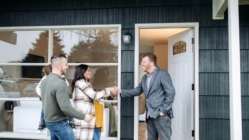
Are you in the real estate market to buy a home and looking for ways to save on your home loan payments? If so, you’ve come to the right place! In this blog post, we’ll be discussing 3-2-1 buydowns, an intriguing option for home buyers.
What Is a 3-2-1 Buydown?
A 3-2-1 buydown is a mortgage financing technique that allows you to temporarily buy down the rate on your monthly mortgage payments during the initial years of your loan. The term “3-2-1” refers to the structure of the buydown. It means that the interest rate on your mortgage is reduced by 3% in the first year, 2% in the second year, and 1% in the third year. After that, your mortgage rate returns to the original agreed-upon market rate, and you begin to make regular mortgage payments based on that rate.
How Does a 3-2-1 Buydown Loan Work?
Let’s assume we have a $100,000 loan and the market rate is 6.5%.
With a 3-2-1 buydown, the borrower would have a 3.5% rate in year one of the mortgage; a 4.5% rate in year two of the mortgage; a 5.5% rate in year three of the mortgage; and a 6.5% (the assumed market rate) thereafter.
In other words, the 3-2-1 buydown buys down the rate 3% in year one; 2% in year two; and 1% in year three.
How Much Does A 3-2-1 Buydown Cost?
While a 3-2-1 buydown can help lower your monthly payments, it’s important to understand that there are costs involved in implementing this strategy. The cost of the buydown is simply the total of the principal and interest (P&I) not paid – via the normal payments over the first three years of the loan.
In the above scenario, the buyer is avoiding approximately $2,200 of P&I in year one; $1,500 of P&I in year two; and $800 of P&I in year three, so the total cost would be approximately $4,500.
3-2-1 temporary buydowns are not treated as traditional buydowns or discount points from a regulator’s perspective, so they must be paid for by anyone who is NOT the buyer. Generally, that would be the seller. The exact amount varies depending on the terms of the buydown program and the size of the mortgage.
3-2-1 Buydown Pros and Cons
Pros of 3-2-1 Buydowns
- Lower initial payments: One of the primary advantages of a 3-2-1 buydown is that it allows you to ease into your mortgage payments. The reduced interest rates in the first few years can provide breathing room for your budget.
- Improved affordability: Lower monthly payments in the early years of homeownership can make a significant difference, particularly for those who anticipate increases in income or have other financial goals to focus on.
Cons of 3-2-1- Buydowns
- Upfront costs: As mentioned earlier, there are upfront costs associated with a 3-2-1 buydown. These costs can vary, depending on various loan factors, but they will be a consideration in negotiations with the sellers.
- Higher interest rates later on:While the reduced interest rates are beneficial in the beginning, it’s essential to remember that after the initial period, your interest rate will return to the original rate. This means that your mortgage payments will increase in subsequent years.
- Not suitable for everyone: A 3-2-1 buydown may not be the best option for everyone. It’s crucial to assess your financial situation, long-term plans, and goals before deciding if a 3-2-1 buydown is the right choice for you.
Temporary vs. Permanent Buydowns
When exploring the world of buydowns, you may come across two common terms: temporary buydowns and permanent buydowns. While both strategies involve reducing mortgage payments, it’s important to understand the differences between them. Let’s take a closer look at temporary and permanent buydowns to help you make an informed decision.
Temporary Buydowns
A temporary buydown, as the name suggests, is a buydown that lasts for a specific period, typically the first few years of the loan. During this period, the interest rate is reduced, resulting in lower monthly mortgage payments.
The key features of a temporary buydown include:
- Gradual reduction: With a temporary buydown, the interest rate is gradually reduced over the designated period. For instance, a 2-1 temporary buydown may lower the interest rate by 2% in the first year and 1% in the second year. After the temporary buydown period ends, the interest rate returns to the original rate, and regular mortgage payments resume.
- Upfront costs: Similar to other buydowns, temporary buydowns require upfront costs. These costs are typically paid by the seller at the time of closing and cover the reduction in interest rate for the designated period. Not every seller is willing to pay for a temporary buydown, so it is recommended you talk to your mortgage lender to ensure this solution works for your homebuying plan.
- Short-term benefits: Temporary buydowns offer immediate benefits in the form of lower monthly payments during the initial years of the loan. This can provide financial relief, increase affordability, or free up funds for other expenses or investments.
Permanent Buydowns
On the other hand, permanent buydowns differ from temporary buydowns in that they provide a long-term reduction in mortgage payments throughout the entire life of the loan. Rather than having the interest rate revert to the original rate after a specific period, permanent buydowns maintain a lower interest rate from the beginning to the end of the loan term.
Here are the key characteristics of a permanent buydown:
- Fixed reduction: With a permanent buydown, the interest rate is permanently reduced by a predetermined percentage. “Permanent buydowns” simply involve paying points to permanently buy down one’s interest rate. One point (1% of the loan amount) usually buys the rate down by about 1/4%.
- Upfront costs: Permanent buydowns involve upfront costs to the buyer that can be significant, depending on how much you “buy down” your rate permanently. It’s important to talk to your mortgage lender to ensure the potential savings outweigh the initial cost.
- Long-term savings: The primary benefit of a permanent buydown is the long-term savings it offers. By maintaining a reduced interest rate throughout the loan term, homeowners can enjoy lower mortgage payments for the entire duration, potentially saving a significant amount of money over the years.
Is a 3-2-1 Buydown Program the Same as an Adjustable-Rate Mortgage (ARM)?
While both involve changes in interest rates, a 3-2-1 mortgage buydown is different from an ARM. With an ARM, the interest rate can fluctuate periodically after the initial fixed-rate period, whereas a 3-2-1 buydown involves a predetermined reduction in interest rates during the initial years.
Can I Refinance My Mortgage After a 3-2-1 Buydown?
Yes, it is possible to refinance your mortgage after a 3-2-1 buydown. Refinancing allows you to explore different loan options and potentially obtain a lower interest rate or change the terms of your loan to better suit your financial goals.
What sets the fees collected for a temporary buydown apart from points paid with a permanent buydown is quite interesting. If you choose to refinance or pay off your loan before the end of the buydown window, the remaining credit held by the servicer will be applied to reducing your principal loan balance. Translation: there is no way you will lose that money by refinancing, unlike paying points. This makes a temporary buydown a great choice for a higher interest rate environment that is likely to soften (and make way for a refinance in the coming few years).
With Rate Watch, we’ll notify you via email when rates drop below your current rate.Get notified when rates drop!
Contact JVM Lending With Any Buydown Questions!
Take control of your mortgage payments and unlock the potential savings that come with a rate buydown. Don’t leave your financial future to chance—reach out to JVM Lending and let our expert team guide you through the process.
With our extensive knowledge and expertise, we’ll help you navigate the intricacies of rate buydowns, ensuring you make informed decisions that align with your goals. Don’t hesitate to contact us with any questions or concerns you may have.
























